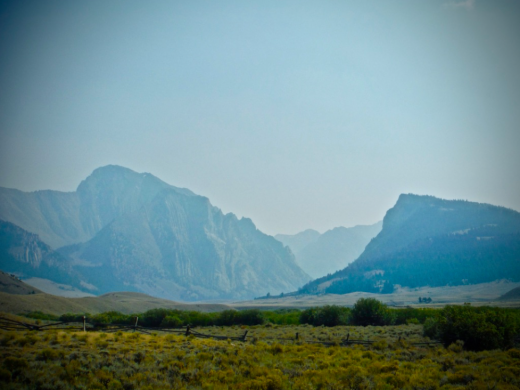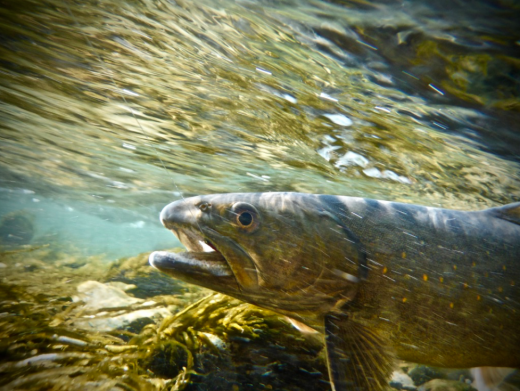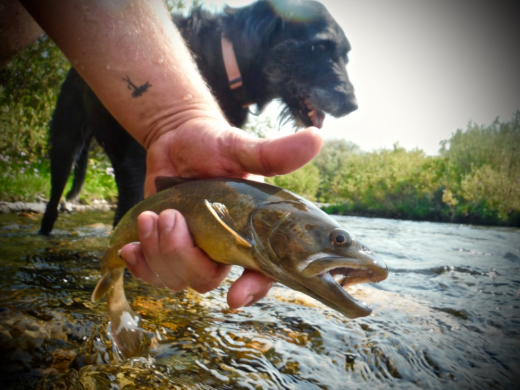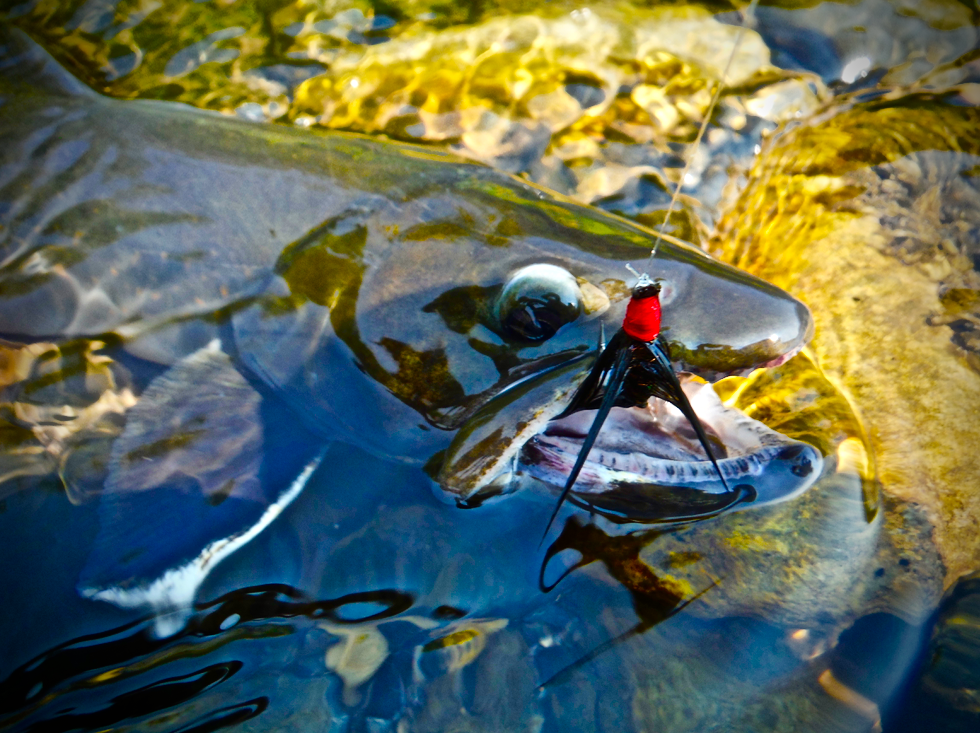By Chris Hunt
The sun filtered through the smoky haze, casting a tarnished glow over the high-country meadow in remote central Idaho. The state’s tallest peaks climbed through the murk, showing up more as silhouettes rather than snow-tipped crags in the near distance. Ma
ny miles away, both human-caused and naturally ignited wildfires consumed timber and sage, sending the acrid exhaust drifting over the landscape.
Everything was still and quiet and hot. The air, heavy with a campfire aroma, felt stagnant and lifeless. But through it all, the river moved.
 Cold and clear, it gobbled up the valley floor on its way to the mighty Salmon, giving way to thickets of willow and shin-eating wild roses. It turned and twisted its way through the meadow, creating deep corner pools, plunges and tail-outs. With every step, summer-fat grasshoppers clumsily lumbered through tall grass and undergrowth, bouncing from willow branches to limber shoots of wild grain to fragrant stands of Rocky Mountain sage.
Cold and clear, it gobbled up the valley floor on its way to the mighty Salmon, giving way to thickets of willow and shin-eating wild roses. It turned and twisted its way through the meadow, creating deep corner pools, plunges and tail-outs. With every step, summer-fat grasshoppers clumsily lumbered through tall grass and undergrowth, bouncing from willow branches to limber shoots of wild grain to fragrant stands of Rocky Mountain sage.
Everything seemed perfect for dry-fly casting to wild and native west slope cutthroats, but, even with the ‘hoppers bouncing around, nothing came to the top. I floated a fat, foam Chernobyl over a likely run, eagerly expecting that purposeful, somewhat lazy cutthroat take, but got nothing. I recast the fly and tilted my head a bit, gazing through polarized lenses into the depths of the dark pool.
Something moved, as if to rise to the fly. But then it settled back down on the bottom. It was big and adorned with creamy white fin tips—that’s the only reason I saw it. As it dropped back to the bottom, the fish disappeared, perfectly blended among the cobble beneath the current.
It was gray and ghostly as it resumed its lie on the river bottom. I had to squint through the moving water, the eerie glow of the sun’s smoke-filtered light making it tough to get a feel for what might be a fish and what might just be a rock.
And then it moved again, pushing upstream a foot or so and dislodging another fish, just as big. I kept my diligent watch, waiting for my “fish-eye” to kick in. These weren’t cutthroats. No sir.
These were bull trout. Big, migratory native char that might have started their journey up this backcountry river in June or July from the Salmon, arriving here to stage for their annual fall spawn. Bull trout are the river’s predators, and early pioneers along this and other Northwest rivers used to treat these threatened fish with disdain. Today, they’re enjoying something of a rebirth, especially among anglers who value the opportunity to catch big fish in small water.
 In Idaho, it’s legal to target bull trout, but illegal to harvest them. This approach to bull trout management might be what saves this native char—close relatives to brook trout, lake trout, Dolly Varden and Arctic char—from further decline. There’s a quiet subculture of Idaho fly anglers out there who seek bull trout out and do their best to fool these beefy, aggressive fish with streamers more representative of small rodents than they are of baitfish.
In Idaho, it’s legal to target bull trout, but illegal to harvest them. This approach to bull trout management might be what saves this native char—close relatives to brook trout, lake trout, Dolly Varden and Arctic char—from further decline. There’s a quiet subculture of Idaho fly anglers out there who seek bull trout out and do their best to fool these beefy, aggressive fish with streamers more representative of small rodents than they are of baitfish.
Trouble was, I didn’t have any small rodents in my fly box. I was extremely prepared for dry-fly fishing for fat backcountry cutthroat trout. But casting to 18- to 20-inch bull trout? Not so much. And, their mere presence likely explained the lack of cutthroats rising to grasshoppers—bull trout are notorious piscivores, and they’ll gobble up cutthroat trout struggling on the end of a stretch of tippet. If I were a hungry cutty, I’d think twice before exposing myself to the angry maws of a big bull trout, too.
That said, I did manage to find a couple of small wet flies that I tied earlier this summer for brown trout in Yellowstone’s Firehole River. Fishing a 3-weight for cutties, though, I was a bit under-equipped to try and grapple with a pre-spawn bull trout.
Of course, that didn’t stop me. Us fly fishers know how to adapt, you know. I cut my leader back and clumsily cast the small “dart” into a run at the head of the pool where I’d seen the first fish, and let a little line out to get the fly down. As it swung tight, I began a purposeful strip, bringing the black-and-red fly back through the depths slowly.
Immediately, the fly drew attention, as I noticed a small (15 inches or so) bull trout rise up from the bottom of the pool and slowly start to follow the fly. I picked up the pace of the retrieve and the fish followed suit, closing quickly. Just before I was sure it was going to hit the fly, it turned away, and I groaned in frustration.
I went to lift the fly out of the water and recast, when, out of nowhere, that gray ghost that I’d noticed a bit earlier glided out from under an overhang and smashed the little streamer. The groan turned into a giddy giggle as my line stretched tight and the fat char trucked into the depths.
Landing the fish on the light tackle was an exercise in patience, but I got the big fish to the bank and admired its fall colors. Bulls aren’t quite as glorious as brook trout when it comes to pre-spawn coloration, but they boast some pretty orange spots and those white fin tips that are indicative of most char. I think what I admire most about bull trout, though, is that they just look … mean. Their heads are a size too big, and their teeth are a bit more “grabby” than those on other salmonids.
I released the big fish back into the pool, and it slithered through the shallows, taking up a lie just below the tailout. I watched it for a bit—a stoic, gray “rock” on the bottom that, if I hadn’t seen it set up shop there, I would have missed entirely.
I pulled a few more big bulls from the icy flows of the stream, pleased each time with the tug and the fight, and even more satisfied as these fish, egos freshly wounded, glided back to their holding waters, stubbornly waiting for the next opportunity at food.
 These fish were fat and happy and healthy—a good reminder that intact habitat matters to trout and char, even if the ecological system as a whole is flawed (remember, the ancestors of these bull trout might have migrated as far downstream as the Pacific via the Salmon, Snake and Columbia rivers—barriers likely keep that from happening now). Here, in one of the many headwaters of the Columbia basin, a cold, clear mountain river provides the opportunity for these fish to carry on and adapt to an ever-changing environment, and for guys like me to experience the thrill they offer at the end of a fly line.
These fish were fat and happy and healthy—a good reminder that intact habitat matters to trout and char, even if the ecological system as a whole is flawed (remember, the ancestors of these bull trout might have migrated as far downstream as the Pacific via the Salmon, Snake and Columbia rivers—barriers likely keep that from happening now). Here, in one of the many headwaters of the Columbia basin, a cold, clear mountain river provides the opportunity for these fish to carry on and adapt to an ever-changing environment, and for guys like me to experience the thrill they offer at the end of a fly line.
Even as smoke filled the valley from fires both natural and unnatural, giving an almost-orange, very eerie aura to the skies over the mountains, I marveled at how wild critters find a way to persist in the face of adversity.
For that, I’m grateful. Because of that, I still have hope.
Chris Hunt is the national digital director for Trout Media. He lives and works in Idaho Falls.



